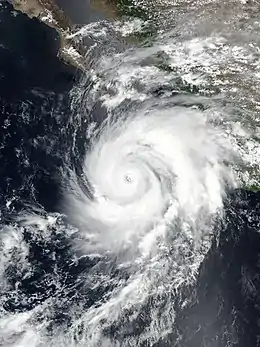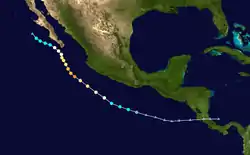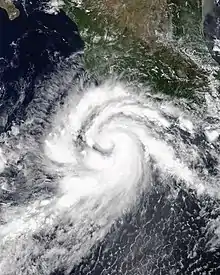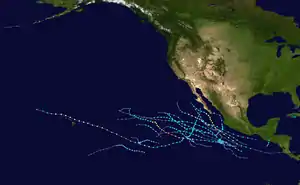Hurricane Genevieve (2020)
Hurricane Genevieve was a strong tropical cyclone that almost made landfall on the Baja California Peninsula in August 2020. The twelfth tropical cyclone, seventh named storm, third hurricane, and second major hurricane of the 2020 Pacific hurricane season, Genevieve formed from a tropical wave that the National Hurricane Center (NHC) first started monitoring on August 10. The wave merged with a trough of low pressure on August 13, and favorable conditions allowed the wave to intensify into Tropical Depression Twelve-E at 15:00 UTC. Just six hours later the depression became a tropical storm and was given the name Genevieve. Genevieve quickly become a hurricane by August 17, and Genevieve began explosive intensification the next day. By 12:00 UTC on August 18, Genevieve reached its peak intensity with winds of 130 mph and a pressure of 950 mbar. Genevieve began to weaken the next day possibly due to cooler waters caused by Hurricane Elida, earlier that month. Genevieve weakened below tropical storm status around 18:00 UTC on August 20, as it passed close to Baja California Sur. Soon after, Genevieve began to lose its deep convection and became a post-tropical cyclone by 21:00 UTC on August 21, eventually dissipating off the coast of Southern California late on August 24.
| Category 4 major hurricane (SSHWS/NWS) | |
 Hurricane Genevieve at peak intensity offshore Mexico on August 18 | |
| Formed | August 16, 2020 |
|---|---|
| Dissipated | August 24, 2020 |
| (Remnant low after August 21) | |
| Highest winds | 1-minute sustained: 130 mph (215 km/h) |
| Lowest pressure | 950 mbar (hPa); 28.05 inHg |
| Fatalities | 6 total |
| Damage | $50 million (2020 USD) |
| Areas affected | Southwestern Mexico, Socorro Island, Baja California Peninsula, Southern California |
| Part of the 2020 Pacific hurricane season | |
Hurricane-force gusts affected parts of Baja California as Genevieve passed close by. Several inches of rain caused flooding near Cabo San Lucas on August 20. A total of six deaths were attributed to Genevieve across Mexico. Total economic losses associated with Genevieve reached US$50 million.[1]
Meteorological history

On August 10, the NHC noted the possibility of an area of low pressure to form near Central America in the next few days.[2] On August 13, this soon came true as a trough of low pressure developed just offshore Central America.[3] The disturbance gradually organized, and on August 16, the system became a tropical depression, receiving the designation Twelve-E at 15:00 UTC.[4] The depression rapidly strengthened and became a tropical storm 6 hours later at 21:00 UTC, receiving the name Genevieve.[5] Genevieve continued to strengthen rapidly overnight as it grew an inner core and became a hurricane on August 17, reaching 1-minute winds of 75 mph (120 km/h).[6][7] Genevieve continued to rapidly intensify as it began to grow an eye along with well-defined banding features, later that day.[8] By 3:00 UTC the next day, Genevieve had intensified into a Category 2 hurricane as strong outflow became evident and the eye began to grow, but remained clouded.[9] Just 6 hours later, Genevieve became a Category 3 hurricane as an eyewall and well-defined eye became visible.[10]
Three hours later, Genevieve intensified further into a Category 4 hurricane.[11] Later that day as Genevieve maintained its intensity, imagery showed an almost circular eye along with a well-defined inner core.[12][13] The next day, Genevieve began to weaken with no signs of an eyewall replacement cycle, hinting at weakening possibly due to a cold wake left behind by Hurricane Elida, earlier that month. Genevieve continued a gradual weakening trend for the next several hours,[14] but later that day, data from an NHC Reconnaissance Flight indicated that Genevieve was rapidly weakening, with the storm dropping to Category 1 status by 21:00 UTC that day.[15] On August 20, Genevieve turned northwestward and passed very close to Cabo San Lucas, at the southern tip of the Baja California Peninsula, and the system weakened further into a tropical storm at 18:00 UTC.[16] By 21:00 UTC on August 21, Genevieve had degenerated into a post-tropical cyclone, after having no deep convection for 12 hours.[17] Hurricane Genevieve's remnant low continued to persist for another few days, stalling off the coast of Southern California on August 23.[18] Genevieve's remnant low dissipated by 00:00 UTC on August 25.[19]
Preparations and impact
Mexico

As Hurricane Genevieve rapidly intensified on August 17, the Government of Mexico issued a tropical storm watch for southern areas of Baja California Sur.[20] This was later raised to a tropical storm warning the next day,[21] and a hurricane warning on August 19.[22] These advisories were subsequently discontinued as the storm weakened and moved away from the Baja California Peninsula on August 21.[23] An estimated 8 million people were threatened by the hurricane across the west coast of Mexico. Accordingly, approximately 1,600 shelters were opened nationwide: 571 in Jalisco, 434 in Nayarit, 237 in Colima, 179 in Michoacán, and 175 in Baja California Sur.[24] Even without officials asking residents to do so, residents of Baja California prepared for damaging winds.[25]
Thunderstorms associated with the outer bands of Genevieve produced gusty winds and heavy rain in Oaxaca, with accumulations averaging 3.0 to 5.9 in (75 to 150 mm) and gusts reaching 43 to 50 mph (70 to 80 km/h).[26] Four people were killed in the state:[27] two from landslides in Huautla de Jiménez and two from swollen rivers.[28] Water reached a depth of 1.6 ft (0.5 m) in Puerto Ángel.[29] The Caminos y Aeropistas de Oaxaca deployed 32 personnel to repair damage to roads.[26] Emergency declarations were issued for 13 municipalities.[28] Localized flash flooding impacted parts of Acapulco, with cars washed away and some homes inundated.[30] Large swells impacted the coast of Jalisco.[31] Fourteen families were relocated in Cihuatlán.[27]
Heavy rainfall impacted much of Baja California Sur as Genevieve brushed the state; accumulations peaked at 11 in (280 mm) in Cabo San Lucas.[32] In the mountainous terrain south of Cabo San Lucas, wind gusts reached 90 mph (140 km/h).[31] Electrical and road infrastructure was damaged statewide,[32] and some areas were without power for more than 24 hours.[33] A lifeguard drowned while attempting to save a teen who also died after ignoring warning flags prompted by rough surf produced by Genevieve, at a resort in Cabo San Lucas.[34] On August 23, the Coordinación Nacional de Protección Civil declared a state of emergency for the municipalities of La Paz and Los Cabos. This allowed the distribution of government aid and supplies to affected residents.[32] Heavy machinery was used to clear roads of debris and mud left behind by floods.[35]
United States
On August 22, moisture from Hurricane Genevieve's remnants brought heavy rainfall to parts of Southern California and Arizona.[36] This brought fears of wildfires in the region, which was already being affected by fires produced by Tropical Storm Fausto just days earlier.[37][38][39] On August 22, a red flag warning was put in effect for most of coastal California.[40] Fortunately, lightning strikes only three small fires that were able to be controlled near the larger SCU Lightning Complex fires.[41] However, storms produced by Genevieve worsened conditions for firefighters battling three other wildfires in the San Francisco Bay Area.[42] A peak wind gust of around 35mph (55 km/h) was reported along Interstate 580 on August 22.[43] Despite this, no monetary damages were reported in association with Genevieve in the United States.[44]
See also
References
- "Global Catastrophe Recap October 2020" (PDF). AON. Retrieved November 12, 2020.
- John Cangialosi (August 10, 2020). "Five-Day Graphical Tropical Weather Outlook". www.nhc.noaa.gov. Miami, Florida: National Hurricane Center. Retrieved August 16, 2020.
- Robbie Berg (August 13, 2020). "Five-Day Graphical Tropical Weather Outlook". www.nhc.noaa.gov. Miami, Florida: National Hurricane Center. Retrieved August 16, 2020.
- Dan Brown (August 16, 2020). "Tropical Depression Twelve-E Public Advisory Number 1". www.nhc.noaa.gov. Miami, Florida: National Hurricane Center. Retrieved August 16, 2020.
- Dan Brown (August 16, 2020). "Tropical Storm Genevieve Public Advisory Number 2". www.nhc.noaa.gov. Miami, Florida: National Hurricane Center. Retrieved August 16, 2020.
- Andrew Latto (August 17, 2020). "Tropical Storm Genevieve Discussion Number 5". www.nhc.noaa.gov. Miami, Florida: National Hurricane Center. Retrieved August 17, 2020.
- Stacy R. Stewart (August 17, 2020). "Tropical Storm Genevieve Discussion Number 3". nhc.noaa.gov. National Hurricane Center. Retrieved December 23, 2020.
- Daniel Brown (August 17, 2020). "Hurricane Genevieve Discussion Number 6". nhc.noaa.gov. Miami, Florida: National Hurricane Center. Retrieved December 23, 2020.
- Stacy R. Stewart (August 18, 2020). "Hurricane Genevieve Discussion Number 7". nhc.noaa.gov. Miami, Florida: National Hurricane Center. Retrieved December 23, 2020.
- Jack Beven (August 18, 2020). "Hurricane Genevieve Discussion Number 8". nhc.noaa.gov. National Hurricane Center. Retrieved December 23, 2020.
- David Zelinsky (August 18, 2020). "Hurricane Genevieve Intermediate Advisory Number 8A". www.nhc.noaa.gov. Miami, Florida: National Hurricane Center. Retrieved August 18, 2020.
- John Cangialosi (August 18, 2020). "Hurricane Genevieve Discussion Number 10". nhc.noaa.gov. Miami, Florida: National Hurricane Center. Retrieved December 23, 2020.
- John Cangialosi (August 18, 2020). "Hurricane Genevieve Advisory Number 10". nhc.noaa.gov. Miami, Florida: National Hurricane Center. Retrieved December 23, 2020.
- Daniel Brown (August 19, 2020). "Hurricane Genevieve Duscussion Number 13". www.nhc.noaa.gov. Miami, Florida: National Hurricane Center. Retrieved August 20, 2020.
- Daniel Brown (August 19, 2020). "Hurricane Genevieve Discussion Number 14". www.nhc.noaa.gov. Miami, Florida: National Hurricane Center. Retrieved August 20, 2020.
- Andrew Latto (August 20, 2020). "Tropical Storm Genevieve Intermediate Advisory Number 17A". www.nhc.noaa.gov. Miami, Florida: National Hurricane Center. Retrieved August 20, 2020.
- Daniel Brown (August 21, 2020). "Post-Tropical Cyclone Genevieve Discussion Number 22". www.nhc.noaa.gov. Miami, Florida: National Hurricane Center. Retrieved August 22, 2020.
- "WPC Surface Analysis valid for 08/23/2020 at 21 UTC". wpc.ncep.noaa.gov. Weather Prediction Center. August 23, 2020. Retrieved August 25, 2020.
- "WPC Surface Analysis valid for 08/25/2020 at 00 UTC". wpc.ncep.noaa.gov. Weather Prediction Center. August 25, 2020. Retrieved August 25, 2020.
- Daniel Brown (August 17, 2020). Hurricane Genevieve Advisory Number 6 (Report). National Hurricane Center. Retrieved October 19, 2020.
- David Zelinsky (August 18, 2020). Hurricane Genevieve Intermediate Advisory Number 8A (Report). National Hurricane Center. Retrieved October 19, 2020.
- Daniel Brown (August 19, 2020). Hurricane Genevieve Advisory Number 13 (Report). National Hurricane Center. Retrieved October 19, 2020.
- Daniel Brown (August 21, 2020). Tropical Storm Genevieve Intermediate Advisory Number 20A (Report). National Hurricane Center. Retrieved October 19, 2020.
- "Más de ocho millones de mexicanos, en riesgo por huracán Genevieve". El Informador (in Spanish). EFE. August 18, 2020. Retrieved October 19, 2020.
- "Hurricane warning in Mexico's Baja California as Genevieve to give close pass". Fox News. Fox News.
- Ángel Camarena (August 17, 2020). "Deja daños leves Huracán Genevieve en Oaxaca" (in Spanish). TVBUS Noticias. Retrieved October 19, 2020.
- "Genevieve deja seis muertos y daños en plena recuperación turística en México" (in Spanish). Telemundo Utah. August 19, 2020. Retrieved October 19, 2020.
- "En Oaxaca, lluvias provocadas por 'Genevieve' dejan cuatro muertos" (in Spanish). MSN News. Tele Diario. August 19, 2020. Retrieved October 19, 2020.
- "Lluvias Provacan Inundaciones el La Costa de Oaxaca" (in Spanish). 24 Horas. August 16, 2020. Retrieved October 19, 2020.
- "Intensas lluvias en Acapulco dejan inundaciones, autos arrastrados y deslaves". El Sud Californiano (in Spanish). August 20, 2020. Retrieved October 19, 2020.
- "Hurricane Genevieve Grazed Mexico's Southern Baja Peninsula With Flooding Rain, High Winds (RECAP)". The Weather Channel. August 20, 2020. Retrieved October 19, 2020.
- Laura Gerardo (August 23, 2020). "Emiten declaratoria de emergencia para La Paz y Los Cabos, BCS por 'Genevieve'" (in Spanish). El Debate. Retrieved October 19, 2020.
- "[Galería] Lluvias por Genevieve inundan centro de Cabo San Lucas". El Sud Californiano. August 20, 2020. Retrieved October 19, 2020.
- "Tropical Storm Genevieve kills two people in western Mexico". Al Jazeera English. Al Jazeera English.
- "Rehabilita Servicios Públicos Calles Afectadas por Lluvias en Los Cabos" (in Spanish). El Informante. August 23, 2020. Retrieved October 19, 2020.
- Jonathan Erdman (August 22, 2020). "Hurricane Genevieve May Be Gone, But Its 'Ghost' May Bring More Thunderstorms to Fire-Ravaged California". weather.com. The Weather Company. Retrieved August 22, 2020.
- Gary Robbins (August 22, 2020). "Thunderstorms could spark wildfires in Southern California on Sunday". sandiegouniontribune.com. The San Diego Union-Tribune. Retrieved December 23, 2020.
- "Cal Fire 72 hour activity". twitter.com. Retrieved August 20, 2020.
- "Moisture from Tropical Storm Fausto fuels NorCal thunderstorms". KTLA. August 16, 2020. Retrieved August 16, 2020.
- "Plume Of Topical Weather Triggers Red Flag Warning For Fire-Ravaged Northern California". sanfransisco.cbslocal.com. KPIX 5. August 22, 2020. Retrieved December 23, 2020.
- "Storm Events Database". National Centers for Environmental Information. August 23, 2021. Retrieved January 27, 2021.
- Harriet Rowan (August 24, 2020). "Bay Area weather: Red flag warning and unhealthy air as forecasters warn of lightning, winds". timesheraldonline.com. Times Herald. Retrieved December 23, 2020.
- "Storm Events Database". National Centers for Environmental Information. August 22, 2020. Retrieved January 27, 2021.
- "Storm Events Database". National Centers for Environmental Information. August 23, 2020. Retrieved January 27, 2021.
